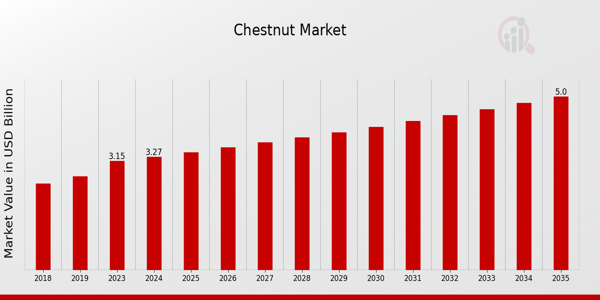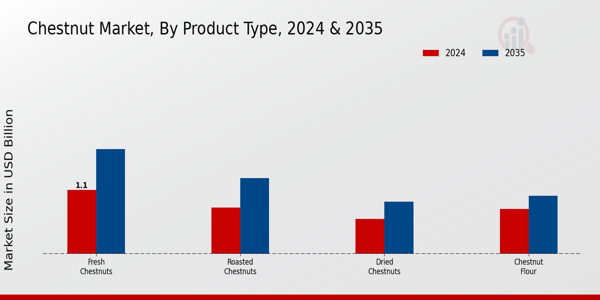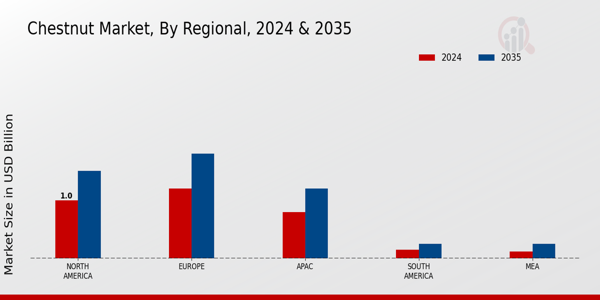Global Chestnut Market Overview
Chestnut Market Size was estimated at 3.15 (USD Billion) in 2023. The Chestnut Market is expected to grow from 3.27 (USD Billion) in 2024 to 5.0 (USD Billion) by 2035. The Chestnut Market CAGR (growth rate) is expected to be around 3.93% during the forecast period (2025 - 2035).
Key Chestnut Market Trends Highlighted
Growing customer demand for natural and healthful snacks is fueling the Chestnut Market. The nutty flavor, nutritional value, and culinary diversity of chestnuts are well known. Plant-based foods have become increasingly popular due to customers' increased health concern, which makes chestnuts a desirable choice.Additionally, their commercial appeal is increased by their use in a variety of international cuisines. The increasing popularity of using chestnuts in savory and baked foods has increased their market presence and created new opportunities for culinary innovation.
Increased investment in processing technologies and product innovation can be used to investigate emerging potential in the chestnut market. Chestnut flour, puree, and ready-to-eat snacks are examples of value-added goods that might be developed to accommodate a range of consumer tastes. Furthermore, there is room for expansion given the growing emphasis on ethically sourced and organic products.
Regions that have favorable climatic conditions for chestnut farming can further explore export opportunities, tapping into international markets that are becoming more aware of the health benefits associated with chestnuts.Recent trends indicate a growing interest in sustainable practices among consumers and producers alike. The shift towards organic farming and ethical sourcing is shaping the market dynamics, as consumers lean towards products aligned with their values.
Furthermore, the popularity of plant-based diets continues to rise, which further boosts the demand for chestnuts as a nutritious alternative to traditional protein sources. This intersection of sustainability and health-consciousness is driving innovation and diversifying product offerings within the chestnut market. Overall, the Chestnut Market is set to experience significant growth as it aligns with changing consumer preferences and embraces innovative practices.

Chestnut Market Drivers
Increasing Health Consciousness Among Consumers
The growing trend of health consciousness among consumers is significantly driving the Chestnut Market. As more individuals become aware of the importance of nutrition and healthier eating habits, the demand for natural, nutrient-rich foods like chestnuts is on the rise.Chestnuts are not only low in fat but also rich in vitamins and minerals, making them an attractive option for health-conscious consumers. This increasing preference for nutritious food options aligns with broader global trends toward healthier lifestyles and dietary choices.
Additionally, chestnuts are gluten-free, which appeals to a wide range of consumers, including those with gluten sensitivities or celiac disease. The versatility of chestnuts, which can be consumed roasted, pureed, or as flour, further enhances their appeal. Moreover, as the global population continues to increase, the demand for high-quality, healthful food sources is expected to rise, driving market growth. This trend shows no signs of abating, and as more research highlights the health benefits of chestnuts, the Chestnut Market is forecast to expand significantly.
The incorporation of chestnuts into various food products, such as snacks, desserts, and savory meals, also broadens their market appeal. The focus on plant-based diets is likely to further fuel appreciation for chestnuts as more consumers seek vegetarian and vegan options. Overall, the shift towards healthier eating habits and the salubrious nature of chestnuts provide a substantial impetus for growth in the Chestnut Market.
Rising Demand for Plant-Based Alternatives
The surge in demand for plant-based alternatives is another prominent driver contributing to the growth of the Chestnut Market. As more consumers opt for vegetarian and vegan lifestyles, the need for diverse plant-based food options rises. Chestnuts, being naturally plant-based and nutritious, are positioned well within this growing market. The versatility of chestnuts, which can be utilized in various culinary applications, further bolsters their attraction among plant-based consumers. As food innovators continue to explore and create new products featuring chestnuts, the market is expected to benefit significantly from this trend.
Growth in Food Processing and Export Opportunities
The expansion of food processing technologies and new export opportunities are key factors driving the Chestnut Market. Advances in food processing allow for the creation of innovative chestnut-based products such as chestnut flour, snacks, and ready-to-eat meals. This enhances the usability of chestnuts and introduces them to new consumer segments. Additionally, the globalization of food supply chains opens up international markets for chestnut producers, enabling them to reach a wider audience and increase their sales figures. As such, the growth in food processing and export avenues is likely to propel the market forward.
Chestnut Market Segment Insights
Chestnut Market Product Type Insights
In the Chestnut Market, the Product Type segmentation showcased a diversified range of offerings, highlighting key segments such as Fresh Chestnuts, Roasted Chestnuts, Dried Chestnuts, and Chestnut Flour. In 2024, the Fresh Chestnut segment held a significant market valuation of 1.1 USD Billion and is projected to rise to 1.8 USD Billion by 2035, marking its position as a leading contributor to the overall market. This substantial growth can be attributed to the rising health awareness among consumers, coupled with a preference for fresh produce that retains nutritional value.
Similarly, Roasted Chestnuts carved out a notable presence in the market, valued at 0.8 USD Billion in 2024 and expected to reach 1.3 USD Billion by 2035. The popularity of roasted chestnuts, often associated with seasonal festivities, enhances their demand, making them a staple snack option in many regions. On the other hand, the Dried Chestnuts segment provided a unique value proposition, with a market valuation of 0.6 USD Billion in 2024, rising to 0.9 USD Billion by 2035. This segment appealed to those seeking long-lasting storage options and versatile ingredients for cooking and baking, thus supporting its steady growth in the market.
Lastly, Chestnut Flour occupied a significant niche within the Chestnut Market, valued at 0.77 USD Billion in 2024 and projected to reach 1.0 USD Billion by 2035. The popularity of gluten-free alternatives has amplified the significance of chestnut flour, catering to a growing demographic focused on health-conscious diets and gluten-free options.Each of these segments contributed distinctively to the Chestnut Market revenue, with Fresh Chestnuts and Roasted Chestnuts commanding the majority in market share. Moreover, the steady increase in consumer preferences for naturally sourced, wholesome products further drives growth across all these product types, facilitating market expansion.
Current trends indicate that marketing and innovation in product offerings, along with growing consumer awareness of health benefits, will likely sustain the upward trajectory of these segments. The Chestnut Market statistics underscored the vitality and resilience of the various product types, indicating ample opportunities for stakeholders to delve deep into consumer preferences and enhance their offerings in line with market dynamics.

Chestnut Market Application Insights
The Chestnut Market showcases a diverse range of applications, reflecting its extensive use across multiple sectors. The Food Industry holds a prominent position, leveraging chestnut's nutritional benefits and versatility in various culinary applications. The Confectionery sector also plays a significant role, utilizing chestnuts for creating unique flavors in sweets and desserts, thus driving consumer interest. Meanwhile, the Cosmetics segment capitalizes on chestnut extracts for their natural skin benefits, contributing to the market's appeal among health-conscious consumers.
Additionally, the Pharmaceuticals industry incorporates chestnuts for their potential health benefits, further enhancing their market relevance. This multifaceted utilization illustrates the importance of the Chestnut Market segmentation, revealing significant growth opportunities that cater to evolving consumer preferences and the demand for healthy and natural products. Market trends indicate a consistent increase in the utilization of chestnuts in these applications, supported by health awareness and a shift towards organic ingredients, driving overall market growth.
Chestnut Market Distribution Channel Insights
The Chestnut Market has been experiencing notable growth, particularly within the Distribution Channel segment. The segmentation of the Chestnut Market showcases various avenues, including Online Retail, Supermarkets, Specialty Stores, and Wholesale channels. Online Retail has gained significant traction as consumers increasingly opt for the convenience of purchasing food items from home, while Supermarkets remain a dominant force due to their expansive reach and established brand presence.
Specialty Stores cater to niche markets, attracting health-conscious consumers who prioritize quality over price, thus playing a vital role in market growth. Conversely, Wholesale channels have traditionally facilitated bulk purchases, supporting both retailers and food services, which is essential in expanding distribution networks. These dynamics highlight the diversity in consumer purchasing behavior, contributing to the overall Chestnut Market revenue and presenting multiple opportunities for stakeholders within the industry as trends shift towards convenience and health-oriented options. The Chestnut Market statistics underline a growing trend for diversified distribution strategies, positioning the market favorably for continued growth and innovation.
Chestnut Market End Use Insights
The End Use segment of the Chestnut Market showcases a diverse range of applications contributing to the overall market growth. This market is primarily driven by the increasing consumer interest in healthy snacking and the growing usage of chestnuts in various food applications such as desserts and gourmet dishes. Within this space, the Residential sector holds significant importance as it caters to individual consumers seeking nutritious options for home cooking and snacking. The Commercial sector, including restaurants and food services, is vital for bulk demand, featuring innovative chestnut-based products in menus, which supports market growth.
Meanwhile, the Industrial segment leverages chestnuts in manufacturing processes, highlighting their versatile applications in non-food sectors. The expected growth scenario reflects an increasing awareness of the nutritional benefits and culinary versatility of chestnuts, which fuels further demand across these End Use categories. Market trends show a steady rise in products made from chestnuts, indicating strong future prospects for the Chestnut Market revenue and its segmentation as it adapts to changing consumer preferences.
Chestnut Market Regional Insights
The Chestnut Market witnessed steady growth across various regions. In 2024, North America held a market valuation of 1.0 USD Billion, placing it as a key player in the industry with significant consumption patterns contributing to its prominence. Europe followed closely, with a valuation of 1.2 USD Billion in 2024, showcasing its strong demand driven by culinary uses and health trends. The APAC region, valued at 0.8 USD Billion in 2024, highlighted emerging markets embracing chestnuts for traditional and modern dishes, marking a growing interest in this nutritious nut.
South America and the MEA, with valuations of 0.15 USD Billion and 0.12 USD Billion, respectively, represented smaller segments in the market but presented opportunities for growth as awareness and demand increased. Collectively, these regions reflected diverse consumption trends, with North America and Europe dominating due to established agricultural practices and market infrastructure, while APAC's growing market was driven by changing dietary preferences. Analyzing the Chestnut Market data and statistics indicated a favorable outlook for regional growth, supported by increasing health consciousness and culinary innovations across these markets.

Chestnut Market Key Players and Competitive Insights
The Chestnut Market exhibits a rich tapestry of competitive dynamics shaped by the growing demand for chestnuts as a versatile food source and ingredient. This market is characterized by a blend of traditional cultivation practices and evolving consumer preferences that prioritize quality, sustainability, and innovative products. Key players in the industry are increasingly focusing on enhancing their supply chain efficiency, investing in marketing strategies to promote chestnut-based products, and leveraging technological advancements to improve production techniques. The challenges in the sector, including climate change and pest management, require companies to stay agile and responsive to both market demands and environmental factors. Understanding competitor strategies, product differentiation, and market entry barriers is crucial for stakeholders aiming for long-term success in this niche yet expanding market.
Marone distinguishes itself in the Chestnut Market through its commitment to quality and sustainability. The company has cultivated a strong presence not only by producing premium-grade chestnuts but also by emphasizing responsible farming practices that ensure environmental stewardship. Marone's strengths lie in its ability to innovate, offering a diverse range of chestnut products that cater to various culinary needs, from gourmet cooking to snacks. The company's focus on maintaining high production standards, coupled with effective branding and robust distribution channels, enhances its competitive edge. Marone's reputation for excellence is further bolstered by its ability to engage with consumers directly, fostering brand loyalty and awareness that translates to a larger market share.
Sicilian Chestnut Company plays a significant role in the Chestnut Market, building its reputation around the high quality of its chestnuts sourced from the idyllic landscapes of Sicily. This company leverages the unique flavor profile and superior characteristics of Sicilian chestnuts, setting them apart from competitors. The Sicilian Chestnut Company's strength lies in its deep-rooted connection to the region, where traditional harvesting methods are blended with modern processing techniques to ensure the preservation of flavor and nutritional value. The company has effectively tapped into the growing trend of organic and locally sourced foods, appealing to health-conscious consumers and those seeking authentic culinary experiences. With a strong commitment to product research and development, Sicilian Chestnut Company continuously explores new avenues for expansion and innovation, positioning itself as a leader in the chestnut market segment.
Key Companies in the Chestnut Market Include
- Marone
- Sicilian Chestnut Company
- Bologna Chestnuts
- Chestnut Woods
- Oroshi Fudo
- Castagna
- Greene's Nut Company
- Settimio
- Kwanwoo
- Chestnut Growers of America
- Sierra Nut Company
- Groupe Crespo
- Seongwoo
- Laudemio
Chestnut Market Developments
Recent developments in the Chestnut Market indicate a growing interest in sustainability and organic practices among key players, with companies like Marone and the Sicilian Chestnut Company actively promoting eco-friendly cultivation methods. Bologna Chestnuts and Chestnut Woods have reported increased demand for their premium organic chestnuts, reflecting a broader trend toward healthy snacking options.
Meanwhile, Oroshi Fudo and Castagna are focusing on expanding their product lines to include value-added products such as chestnut flour and roasted snacks, catering to diverse consumer preferences. There have been notable mergers and acquisitions within the sector; for instance, Greene's Nut Company is rumored to be in acquisition discussions with Sierra Nut Company to expand its market share.
Groupe Crespo has also been enhancing its operational capabilities, which could lead to more significant market consolidation. Current market valuations have seen an uptick, with estimates suggesting a robust growth trajectory due to heightened consumer interest in plant-based snacks. Companies like Kwanwoo and Chestnut Growers of America are expected to benefit as retail opportunities expand in line with this trend, further shaping the market landscape.
Chestnut Market Segmentation Insights
- Chestnut Market Product Type Outlook
- Fresh Chestnuts
- Roasted Chestnuts
- Dried Chestnuts
- Chestnut Flour
- Chestnut Market Application Outlook
- Food Industry
- Confectionery
- Cosmetics
- Pharmaceuticals
- Chestnut Market Distribution Channel Outlook
- Online Retail
- Supermarkets
- Specialty Stores
- Wholesale
- Chestnut Market End Use Outlook
- Residential
- Commercial
- Industrial
- Chestnut Market Regional Outlook
- North America
- Europe
- South America
- Asia Pacific
- Middle East and Africa
Chestnut Market Report Scope
|
Report Attribute/Metric
|
Details
|
|
Market Size 2023
|
3.15(USD Billion)
|
|
Market Size 2024
|
3.27(USD Billion)
|
|
Market Size 2035
|
5.0(USD Billion)
|
|
Compound Annual Growth Rate (CAGR)
|
3.93% (2025 - 2035)
|
|
Report Coverage
|
Revenue Forecast, Competitive Landscape, Growth Factors, and Trends
|
|
Base Year
|
2024
|
|
Market Forecast Period
|
2025 - 2035
|
|
Historical Data
|
2019 - 2024
|
|
Market Forecast Units
|
USD Billion
|
|
Key Companies Profiled
|
Marone, Sicilian Chestnut Company, Bologna Chestnuts, Chestnut Woods, Oroshi Fudo, Castagna, Greene's Nut Company, Settimio, Kwanwoo, Chestnut Growers of America, Sierra Nut Company, Groupe Crespo, Seongwoo, Laudemio
|
|
Segments Covered
|
Product Type, Application, Distribution Channel, End Use, Regional
|
|
Key Market Opportunities
|
Organic chestnut products expansion, Growing demand for gluten-free options, Increasing popularity of plant-based foods, Rising health consciousness among consumers, Enhanced product innovation in snacks
|
|
Key Market Dynamics
|
Rising health consciousness, Increasing demand for organic produce, Fluctuating weather conditions, Expanding gourmet food sector, Growth of processed chestnut products
|
|
Countries Covered
|
North America, Europe, APAC, South America, MEA
|
Frequently Asked Questions (FAQ) :
The Chestnut Market was valued at 3.27 USD Billion by the year 2024.
By the year 2035, the Chestnut Market is projected to reach a value of 5.0 USD Billion.
The expected Compound Annual Growth Rate (CAGR) for the Chestnut Market from 2025 to 2035 is 3.93%.
In 2024, Europe held the highest market value at 1.2 USD Billion.
The market value of Fresh Chestnuts is projected to be 1.8 USD Billion in 2035.
By 2035, the market value for Dried Chestnuts is expected to reach 0.9 USD Billion.
Major players in the Chestnut Market include Marone, Sicilian Chestnut Company, and Bologna Chestnuts, among others.
The expected market size for Roasted Chestnuts in 2024 was valued at 0.8 USD Billion.
The market value of Chestnut Flour is projected to be 1.0 USD Billion by the year 2035.
The APAC region is projected to grow from 0.8 USD Billion in 2024 to 1.2 USD Billion by 2035.

















